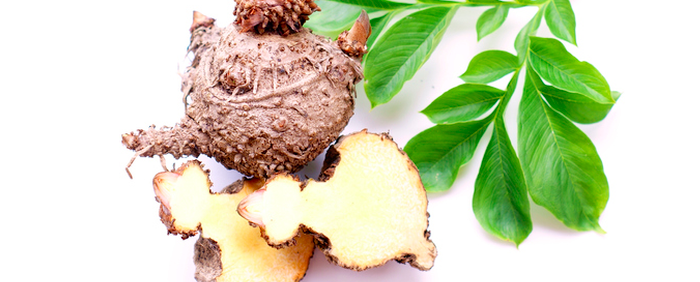
Konjac, or Amorphophallus konjac, is a plant native to Southeast Asia. Its bulb has been used for culinary and therapeutic purposes for several centuries. In western countries, konjac is best known in herbal medicine for its natural appetite suppressant effect. Rich in fiber and low in calories, konjac is often recommended as part of a slimming diet.
Common names: Konjac, devil’s tongue, konnyaku, shirataki, konjac flour.
Scientific names: Amorphophallus konjac, Amorphophallus rivieri
Family: Araceae
The health benefits of konjac
Appetite suppressing effect of konjac
In phytotherapy, konjac is a plant known for its natural appetite suppressant effect . It is indeed able to reduce the feeling of hunger thanks to its high fiber content.
Digestive benefits of konjac
In Asia, konjac is commonly used to fight against digestive disorders such as constipation . The digestive benefits of konjac are due to its fibers which help improve intestinal transit.
Detoxifying action of konjac
By helping to improve intestinal transit, the fibers of konjac also promote the elimination of waste and toxins present in the body.
Cholesterol-lowering effect of konjac
According to some studies, konjac also has a cholesterol-lowering action. Researchers have shown that supplementing with konjac could help lower total cholesterol and LDL cholesterol levels in the body. Thanks to this cholesterol-lowering effect, konjac could therefore be of interest for the prevention of certain cardiovascular disorders . Additional studies are also underway on this subject.
Hypoglycemic effect of konjac
Other researchers attribute a hypoglycemic action to konjac. It seems that the fibers present in the konjac would slow the release of glucose . This action would help lower blood sugar , the level of glucose in the blood. Although additional studies are awaited to confirm this discovery, these first results open promising prospects for combating hyperglycemia, particularly in the context of diabetes .
Nutritional value and composition of konjac
Nutritional value of konjac
Konjac owes its health benefits to its nutritional composition. It is recognized to be:
- low in calories , which makes it a slimming ally, especially as part of a slimming diet;
- rich in fiber , which gives it its appetite suppressant effect, its digestive properties and its detoxifying action.
Fiber content of konjac
Studies on konjac have shown a high content of glucomannan , a very specific soluble fiber. Within the dietary fiber family, this substance has one of the highest molecular weights and one of the highest viscosities. These are the characteristics that give glucomannan its many beneficial effects within the body. Its structure allows it in particular to increase the effect of satiety.
Use of konjac in herbal medicine
Konjac conditioning
In Europe, konjac is best known as an appetite suppressant . Konjac supplements are often recommended as part of a minor cure. They are packaged in the form of capsules and have a composition which varies depending on the manufacturer.
Precautions for using konjac
A course of konjac requires some precautions to avoid the occurrence of side effects. An excess of konjac can indeed be responsible for undesirable effects such as flatulence, loose stools and a feeling of overflow.
When taking konjac supplements, you should:
- respect the recommended dosages ;
- drink a large glass of water ;
- do a short course of treatment .
It is also advisable for patients under medical treatment to space at least 3 hours when taking a konjac supplement and taking medication . The action of konjac within the body can alter the bioavailability of the active ingredients in the drug.
Note: If in doubt, it is best to seek medical advice before starting a konjac treatment.
Use of konjac in cooking
What are the konjac preparations?
In Asia, konjac is commonly used in cooking. Its underground parts can be eaten as a vegetable but can also be used for the production of konjac flour. This can be used in several culinary preparations.
Konjac is available for sale in many forms such as:
- konjac flour ;
- konjac jelly , also known as konnyaku, which is a traditional Japanese preparation made from konjac flour and lime water;
- konjac noodles or vermicelli , also called shirataki;
- konjac tagliatelle ;
- konjac rice ;
- the konjac pearls .
How to use konjac in cooking?
In Europe, konjac is mainly found in the form of noodles, tagliatelle or rice. These products can be used in the same way as wheat-based pasta . Konjac noodles can for example be incorporated into a vegetable wok, serve as an accompaniment to meat or fish, or even be the basis of a salad.
Noodles, tagliatelle and konjac rice are generally packaged with a preserving liquid. This is why they should be rinsed in cold water before cooking in a large volume of boiling water . Their cooking is similar to that of wheat-based pasta but requires only 3 to 4 minutes.
Little history of konjac
Traditional use of konjac
In Asia, konjac has been considered a medicinal plant for several thousand years. Present in the Chinese Pharmacopoeia, it is traditionally used for the treatment of many ailments including cough, asthma, certain pains and certain skin problems.
Botanical nickname of konjac
Konjac is a perennial tropical plant from the Araceae family. It is sometimes nicknamed “devil’s tongue” because of its red color and its very particular shape.